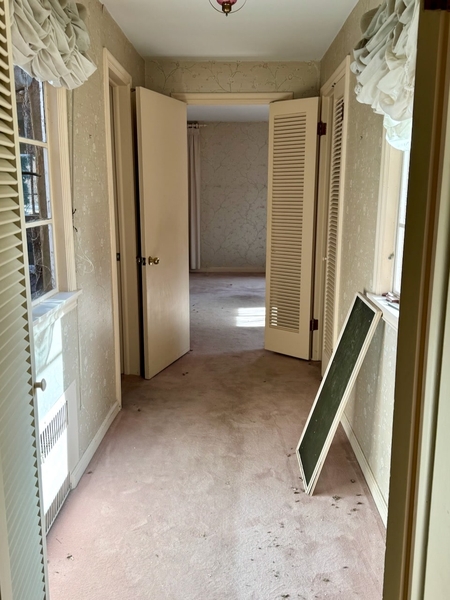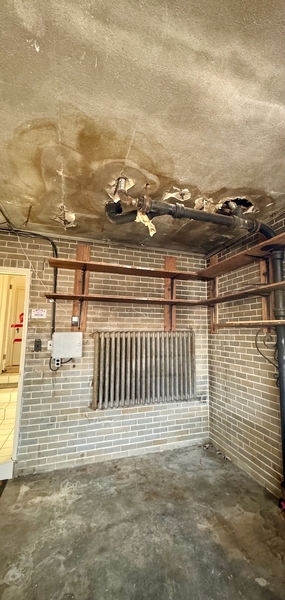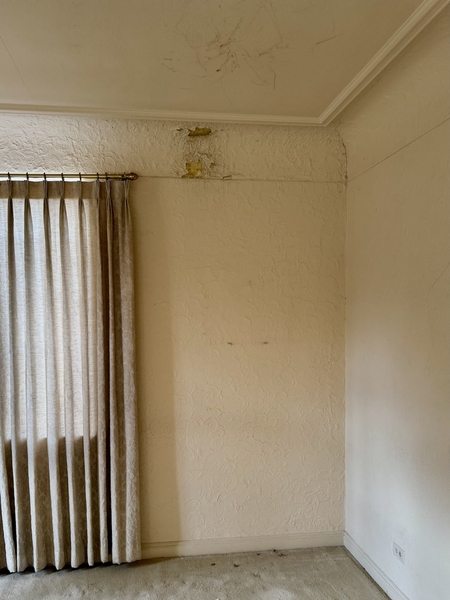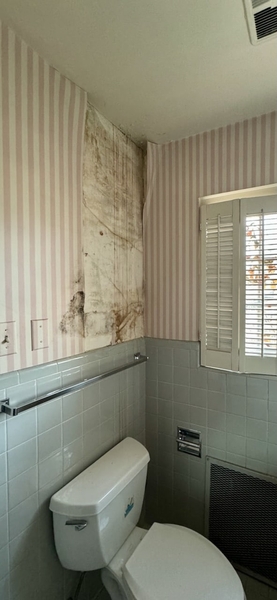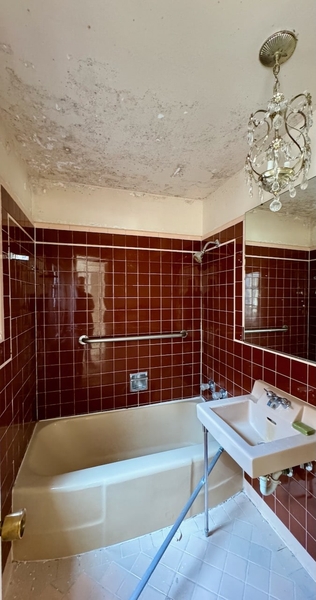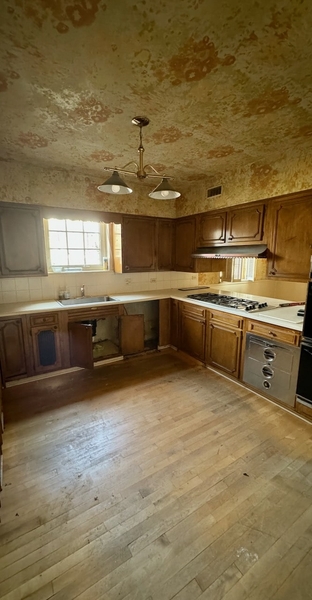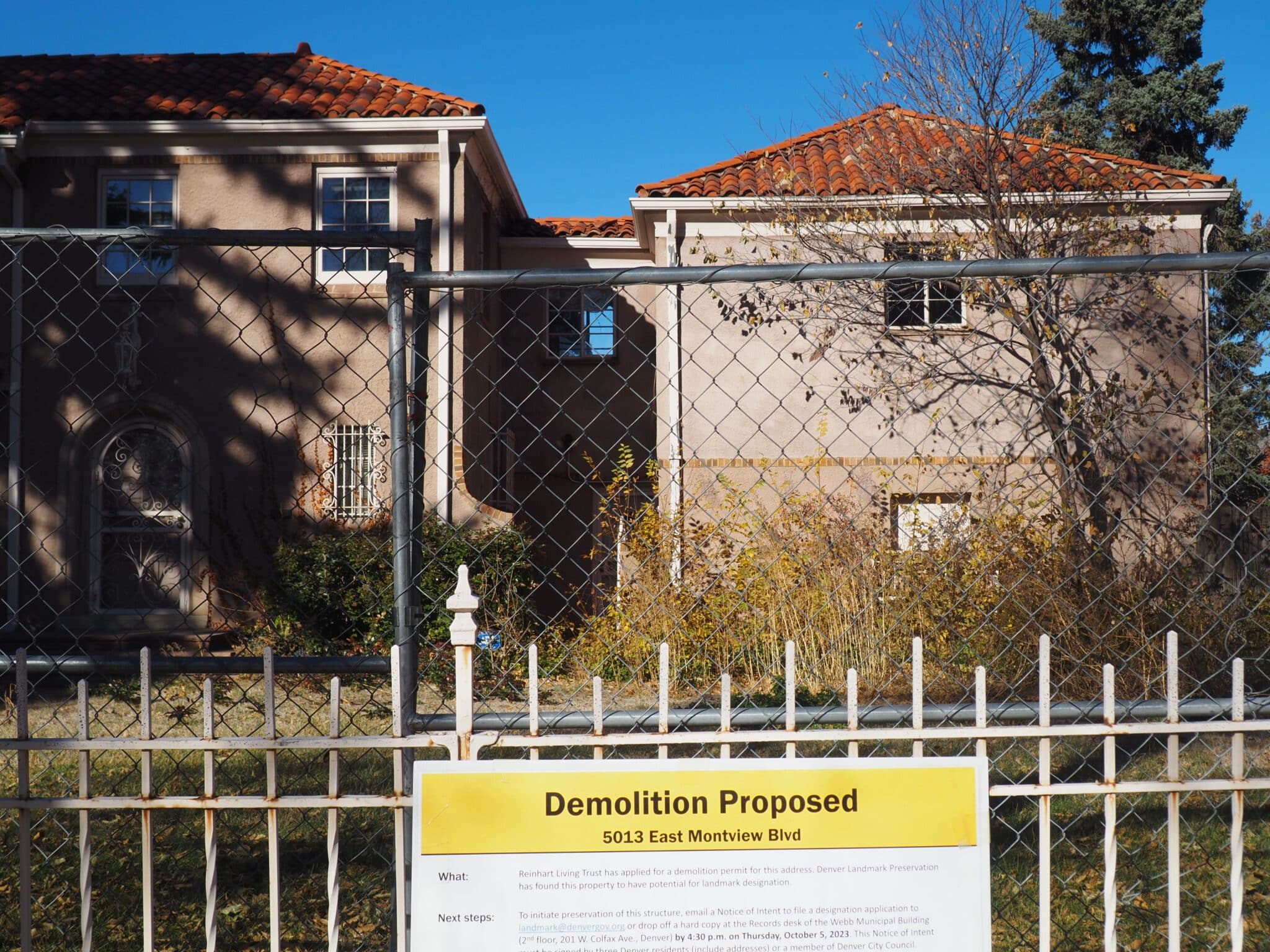
The new owner of this home at 5013 E. Montview Blvd. in Denver would like to demolish it and build a new one. (Thomas Gounley/BusinessDen)
In September 2022, a nearly century-old home in South Park Hill sold for the first time since the 1950s.
The new owners paid $2.5 million, records show — for the land. They’d like to demolish the structure and build something much larger, plans indicate.
But a handful of Denver residents are pushing to mandate preservation of the home.
The property at 5013 E. Montview Blvd., along one of the neighborhood’s stately corridors, is Denver’s latest setting for an owner-opposed landmark application. Three women who live nearby, with the help of the nonprofit Historic Denver, submitted the application earlier this month.
“If this home is capable of being designated as a landmark, anyone buying or selling a home in Denver should be concerned,” said Mark Rinehart, who owns the home with his wife.
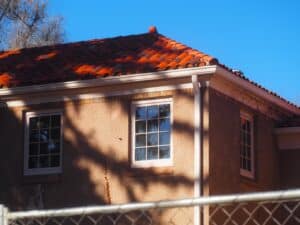
The home’s style is “simplified Italian Renaissance Revival,” according to those wishing to save it. (Thomas Gounley/BusinessDen)
The application comes months after the Denver City Council approved an owner-opposed landmark application for just the second time ever. A subsequent lawsuit filed by the owner of that home in City Park West, a developer who hoped to build apartments, was recently paused.
Records show that Mark and Marianne Rinehart bought the two-story, 3,200-square-foot Park Hill home through a trust last year. Prior to that, another couple, now deceased, had owned it since 1959. The home is fenced off and unoccupied.
Mark Rinehart is a founder of Legal TV Leads, which helps personal injury attorneys with television advertising, according to his LinkedIn profile. He previously worked in advertising for Denver’s Fox31/KDVR.
A contractor working for the couple requested a demolition permit over the summer, records show. Following a regular process, city staff that reviewed the demolition request set aside time in case anyone wanted to lobby the city to name the structure a landmark.
Landmark designation effectively prevents demolition of a structure. The city generally sees a handful of owner-opposed landmark applications a year. Most don’t result in designation, but in some cases the owners and preservationists reach some sort of compromise, like in the case of the Tom’s Diner building along Colfax.
Owner-opposed landmark designation applications must be filed by at least three Denver residents. The one in Park Hill was filed by Margaret McRoberts, Trish Leary and Bernadette Kelly. Each indicated they live within a mile. Kelly and the CEO of Historic Denver, which helped draft the application, did not respond to separate requests for comment Friday.
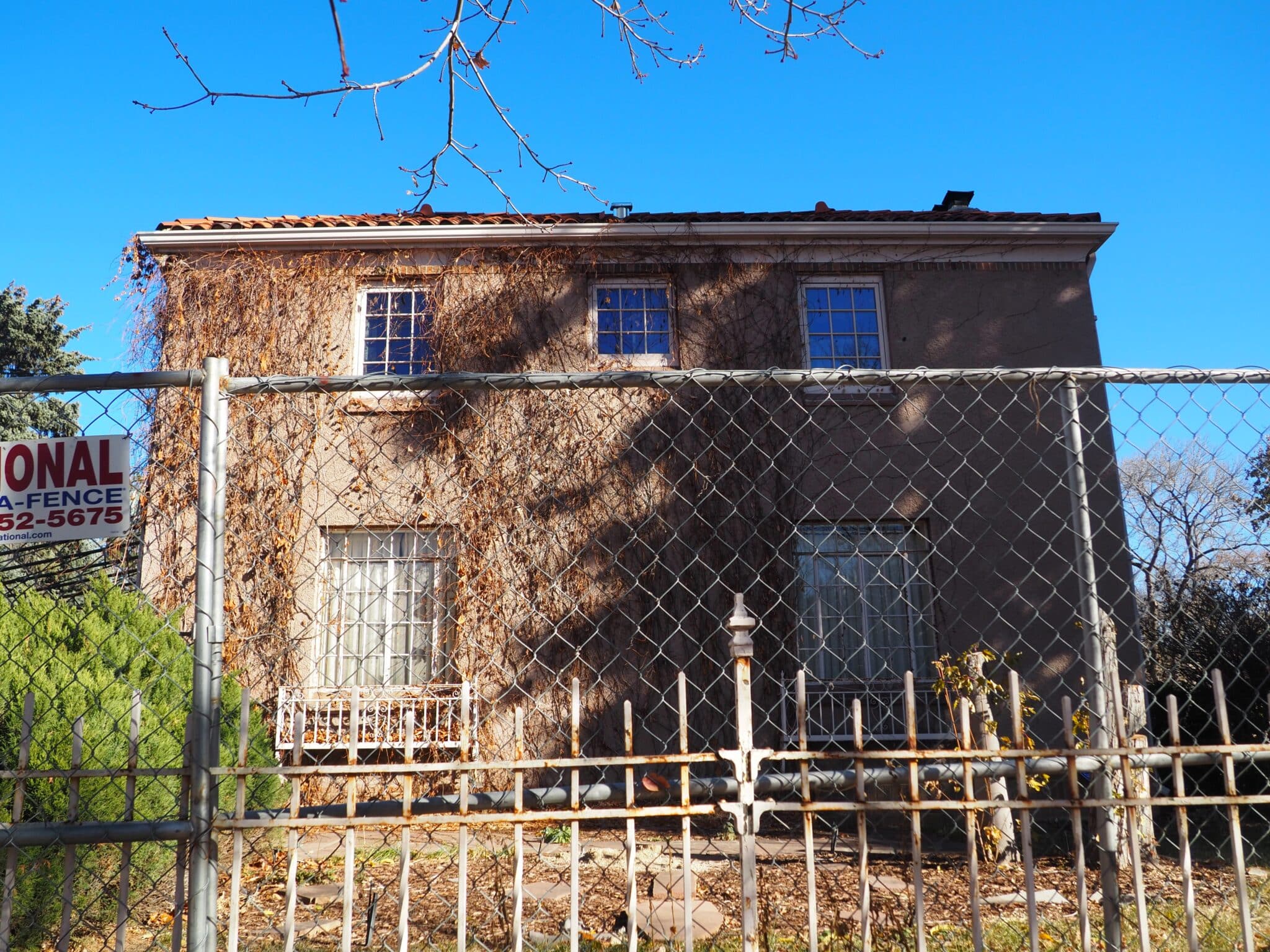
The side of the home at 5013 E. Montview Blvd. (Thomas Gounley/BusinessDen)
The home dates to the mid-1930s. The applicants pointed to the home’s previous occupants, prominent location, architectural style and original homebuilder as reasons to preserve it.
The original residents were Harry Eugene Huffman and his wife Christina Mae. Huffman owned and managed movie theaters in the Denver area, according to the applicants. He later moved to the “Shangri-La” mansion he built at 150 S. Bellaire St. in Hilltop.
The Park Hill house was then owned by Robert and Betty McClennan Hawley. He was a lawyer, and she was a socialite and philanthropist, according to the applicants. Then came Universal Tractor Co. owners Alston McCarty and his wife Ann, who had the property for more than 60 years. The home was sold to the Rineharts after their deaths.
The home exemplifies the “simplified Italian Renaissance Revival” style, and was built by Douglas M. Sugg, according to the applicants.
“The home has been a prominent and familiar building along Montview Boulevard for over 89 years,” they wrote.
Denver’s landmark process only takes into account the exterior of a structure. Reached by BusinessDen, however, the first thing Rinehart did was email photos of the interior of 5013 E. Montview.
The photos show cracked walls and stained, deteriorating ceilings. The roof was not properly maintained, Rinehart said, which resulted in leaks and mold. The electrical system needs to be replaced, he said. The foundation has settled. An addition isn’t level with the rest of the home.
“As you can see from the pictures, it would take considerable work and expense to make the home safe to live in, much less structurally sound,” Rinehart said by email. “Because of the roof issues and water damage, I don’t even know how much of the original structure could even be salvaged.”
Plans submitted to the city earlier this year indicate the Rineharts want to build a new two-story brick home on the 0.43-acre lot. It would be about 7,500 square feet counting finished basement space, plans show. An outdoor pool was initially proposed, but later nixed.

A drawing showing the design of the proposed new home as of August. (Development plans via City of Denver)
Rinehart said nothing has been finalized, but the goal is to build a “forever family home” that “fits the character of the neighborhood and is consistent with the beautiful homes around it.” The family has lived elsewhere in Park Hill for over a decade.
Denver’s process for owner-opposed landmark applications requires those seeking preservation to attend mediation sessions with the property owner before filing. Three sessions were held, but the two sides “were unable to come to an agreement on a compromise between complete demolition and preservation of the original contributing structure,” according to the application.

Mark Rinehart and family (Courtesy Mark Rinehart)
Even if the physical condition of the home isn’t considered, Rinehart said he doesn’t think the home is worthy of being a landmark.
“It was built as a spec home by a home builder who was not well known for any style of architecture or unique home building qualities, and was lived in for a brief moment in time by someone who ultimately built a much more notable home in Denver: the Shangri La house,” he said.
The application will be reviewed by Denver’s Landmark Preservation Commission, which will decide whether to send it to the City Council for a vote.
Another owner-opposed landmark application could come in soon. Three individuals, including a Historic Denver employee, have signaled they might submit one for the home at 3601 E. 26th Ave., which faces City Park Golf Course in the Skyland neighborhood. They have until Nov. 27 to do so.

The new owner of this home at 5013 E. Montview Blvd. in Denver would like to demolish it and build a new one. (Thomas Gounley/BusinessDen)
In September 2022, a nearly century-old home in South Park Hill sold for the first time since the 1950s.
The new owners paid $2.5 million, records show — for the land. They’d like to demolish the structure and build something much larger, plans indicate.
But a handful of Denver residents are pushing to mandate preservation of the home.
The property at 5013 E. Montview Blvd., along one of the neighborhood’s stately corridors, is Denver’s latest setting for an owner-opposed landmark application. Three women who live nearby, with the help of the nonprofit Historic Denver, submitted the application earlier this month.
“If this home is capable of being designated as a landmark, anyone buying or selling a home in Denver should be concerned,” said Mark Rinehart, who owns the home with his wife.

The home’s style is “simplified Italian Renaissance Revival,” according to those wishing to save it. (Thomas Gounley/BusinessDen)
The application comes months after the Denver City Council approved an owner-opposed landmark application for just the second time ever. A subsequent lawsuit filed by the owner of that home in City Park West, a developer who hoped to build apartments, was recently paused.
Records show that Mark and Marianne Rinehart bought the two-story, 3,200-square-foot Park Hill home through a trust last year. Prior to that, another couple, now deceased, had owned it since 1959. The home is fenced off and unoccupied.
Mark Rinehart is a founder of Legal TV Leads, which helps personal injury attorneys with television advertising, according to his LinkedIn profile. He previously worked in advertising for Denver’s Fox31/KDVR.
A contractor working for the couple requested a demolition permit over the summer, records show. Following a regular process, city staff that reviewed the demolition request set aside time in case anyone wanted to lobby the city to name the structure a landmark.
Landmark designation effectively prevents demolition of a structure. The city generally sees a handful of owner-opposed landmark applications a year. Most don’t result in designation, but in some cases the owners and preservationists reach some sort of compromise, like in the case of the Tom’s Diner building along Colfax.
Owner-opposed landmark designation applications must be filed by at least three Denver residents. The one in Park Hill was filed by Margaret McRoberts, Trish Leary and Bernadette Kelly. Each indicated they live within a mile. Kelly and the CEO of Historic Denver, which helped draft the application, did not respond to separate requests for comment Friday.

The side of the home at 5013 E. Montview Blvd. (Thomas Gounley/BusinessDen)
The home dates to the mid-1930s. The applicants pointed to the home’s previous occupants, prominent location, architectural style and original homebuilder as reasons to preserve it.
The original residents were Harry Eugene Huffman and his wife Christina Mae. Huffman owned and managed movie theaters in the Denver area, according to the applicants. He later moved to the “Shangri-La” mansion he built at 150 S. Bellaire St. in Hilltop.
The Park Hill house was then owned by Robert and Betty McClennan Hawley. He was a lawyer, and she was a socialite and philanthropist, according to the applicants. Then came Universal Tractor Co. owners Alston McCarty and his wife Ann, who had the property for more than 60 years. The home was sold to the Rineharts after their deaths.
The home exemplifies the “simplified Italian Renaissance Revival” style, and was built by Douglas M. Sugg, according to the applicants.
“The home has been a prominent and familiar building along Montview Boulevard for over 89 years,” they wrote.
Denver’s landmark process only takes into account the exterior of a structure. Reached by BusinessDen, however, the first thing Rinehart did was email photos of the interior of 5013 E. Montview.
The photos show cracked walls and stained, deteriorating ceilings. The roof was not properly maintained, Rinehart said, which resulted in leaks and mold. The electrical system needs to be replaced, he said. The foundation has settled. An addition isn’t level with the rest of the home.
“As you can see from the pictures, it would take considerable work and expense to make the home safe to live in, much less structurally sound,” Rinehart said by email. “Because of the roof issues and water damage, I don’t even know how much of the original structure could even be salvaged.”
Plans submitted to the city earlier this year indicate the Rineharts want to build a new two-story brick home on the 0.43-acre lot. It would be about 7,500 square feet counting finished basement space, plans show. An outdoor pool was initially proposed, but later nixed.

A drawing showing the design of the proposed new home as of August. (Development plans via City of Denver)
Rinehart said nothing has been finalized, but the goal is to build a “forever family home” that “fits the character of the neighborhood and is consistent with the beautiful homes around it.” The family has lived elsewhere in Park Hill for over a decade.
Denver’s process for owner-opposed landmark applications requires those seeking preservation to attend mediation sessions with the property owner before filing. Three sessions were held, but the two sides “were unable to come to an agreement on a compromise between complete demolition and preservation of the original contributing structure,” according to the application.

Mark Rinehart and family (Courtesy Mark Rinehart)
Even if the physical condition of the home isn’t considered, Rinehart said he doesn’t think the home is worthy of being a landmark.
“It was built as a spec home by a home builder who was not well known for any style of architecture or unique home building qualities, and was lived in for a brief moment in time by someone who ultimately built a much more notable home in Denver: the Shangri La house,” he said.
The application will be reviewed by Denver’s Landmark Preservation Commission, which will decide whether to send it to the City Council for a vote.
Another owner-opposed landmark application could come in soon. Three individuals, including a Historic Denver employee, have signaled they might submit one for the home at 3601 E. 26th Ave., which faces City Park Golf Course in the Skyland neighborhood. They have until Nov. 27 to do so.

